Table Of ContentComputer Science and Engineering Bertolotti
Hu
Embedded
Embedded Software Development
The Open-Source Approach E Software
m
“… provides a consistent description covering many aspects of embedded systems
development and explains their interrelationships, which is a very important comple-
ment to other in-depth literature. … As such, this book fills a gap ... and will prove b
valuable to students and professionals who need a single, coherent source of e Development
information.”
d
—Kristian Sandström, ABB Corporate Research, Västerås, Sweden
d
Embedded Software Development: The Open-Source Approach delivers a practi-
e
cal introduction to embedded software development, with a focus on open-source
components. This programmer-centric book is written in a way that enables even novice d The Open-Source Approach
practitioners to grasp the development process as a whole.
S
Incorporating real code fragments and explicit, real-world open-source operating
system references (in particular, FreeRTOS) throughout, the text: o
• Defines the role and purpose of embedded systems, describing their internal f
t
structure and interfacing with software development tools
w
• Examines the inner workings of the GNU compiler collection (GCC)-based
software development system or, in other words, toolchain
a
• Presents software execution models that can be adopted profitably to
model and express concurrency r
• Addresses the basic nomenclature, models, and concepts related to task-based e
scheduling algorithms
• Shows how an open-source protocol stack can be integrated in an embedded D
system and interfaced with other software components
e
• Analyzes the main components of the FreeRTOS Application Programming Interface
(API), detailing the implementation of key operating system concepts v
• Discusses advanced topics such as formal verification, model checking, runtime
e
checks, memory corruption, security, and dependability
l
o
Embedded Software Development: The Open-Source Approach capitalizes on the
p
authors’ extensive research on real-time operating systems and communications used
in embedded applications, often carried out in strict cooperation with industry. Thus, the m
book serves as a springboard for further research.
e
n
t
K20656
Ivan Cibrario Bertolotti
ISBN 978-1-4665-9392-3
90000
Tingting Hu
9 781466 593923
Embedded
Software
Development
The Open-Source Approach
Embedded Systems
Series Editor
Richard Zurawski
ISA Corporation, San Francisco, California, USA
Embedded Software Development: The Open-Source Approach,
Ivan Cibrario Bertolotti and Tingting Hu
Event-Based Control and Signal Processing, edited by Marek Miskowicz
Real-Time Embedded Systems: Open-Source Operating Systems Perspective,
Ivan Cibrario Bertolotti and Gabriele Manduchi
Time-Triggered Communication, edited by Roman Obermaisser
Communication Architectures for Systems-on-Chip, edited by José L. Ayala
Embedded
Software
Development
The Open-Source Approach
Ivan Cibrario Bertolotti
National Research Council of Italy
Turin, Italy
Tingting Hu
National Research Council of Italy
Politecnico di Torino
Turin, Italy
Boca Raton London New York
CRC Press is an imprint of the
Taylor & Francis Group, an informa business
CRC Press
Taylor & Francis Group
6000 Broken Sound Parkway NW, Suite 300
Boca Raton, FL 33487-2742
© 2016 by Taylor & Francis Group, LLC
CRC Press is an imprint of Taylor & Francis Group, an Informa business
No claim to original U.S. Government works
Version Date: 20151027
International Standard Book Number-13: 978-1-4665-9393-0 (eBook - PDF)
This book contains information obtained from authentic and highly regarded sources. Reasonable
efforts have been made to publish reliable data and information, but the author and publisher cannot
assume responsibility for the validity of all materials or the consequences of their use. The authors and
publishers have attempted to trace the copyright holders of all material reproduced in this publication
and apologize to copyright holders if permission to publish in this form has not been obtained. If any
copyright material has not been acknowledged please write and let us know so we may rectify in any
future reprint.
Except as permitted under U.S. Copyright Law, no part of this book may be reprinted, reproduced,
transmitted, or utilized in any form by any electronic, mechanical, or other means, now known or
hereafter invented, including photocopying, microfilming, and recording, or in any information stor-
age or retrieval system, without written permission from the publishers.
For permission to photocopy or use material electronically from this work, please access www.copy-
right.com (http://www.copyright.com/) or contact the Copyright Clearance Center, Inc. (CCC), 222
Rosewood Drive, Danvers, MA 01923, 978-750-8400. CCC is a not-for-profit organization that pro-
vides licenses and registration for a variety of users. For organizations that have been granted a photo-
copy license by the CCC, a separate system of payment has been arranged.
Trademark Notice: Product or corporate names may be trademarks or registered trademarks, and are
used only for identification and explanation without intent to infringe.
Visit the Taylor & Francis Web site at
http://www.taylorandfrancis.com
and the CRC Press Web site at
http://www.crcpress.com
Che´ nessunquaggiu` lasciamo,
ne´ timore,ne´ desir
(Forweleavenoonebehindus,
nordreads,nordesires)
—Ivan
(ThisbookisdedicatedtomygrandfatherChenGuanglu,
mygrandmotherSongFengzhi)
—Tingting
Contents
Foreword.................................................................................................................xiii
Preface....................................................................................................................xvii
TheAuthors............................................................................................................xix
ListofFigures.........................................................................................................xxi
ListofTables..........................................................................................................xxv
Chapter1 Introduction..........................................................................................1
PART I Basics of Embedded Software Development
Chapter2 EmbeddedApplicationsandTheirRequirements................................9
2.1 RoleandPurposeofEmbeddedSystems...................................9
2.2 MicrocontrollersandTheirInternalStructure..........................13
2.2.1 FlashMemory..............................................................15
2.2.2 StaticRandomAccessMemory(SRAM)....................17
2.2.3 ExternalMemory.........................................................19
2.2.4 On-ChipInterconnectionArchitecture........................23
2.3 General-PurposeProcessorsversusMicrocontrollers..............29
2.4 EmbeddedSoftwareDevelopmentProcess..............................32
2.5 Summary...................................................................................37
Chapter3 GCC-BasedSoftwareDevelopmentTools........................................39
3.1 Overview...................................................................................40
3.2 CompilerDriverWorkflow.......................................................42
3.3 CPreprocessorWorkflow.........................................................44
3.4 TheLinker................................................................................48
3.4.1 SymbolResolutionandRelocation..............................49
3.4.2 InputandOutputSequences........................................51
3.4.3 MemoryLayout...........................................................55
3.4.4 LinkerScriptSymbols.................................................58
3.4.5 SectionandMemoryMapping.....................................59
vii
viii Contents
3.5 TheCRuntimeLibrary.............................................................62
3.6 ConfiguringandBuildingOpen-SourceSoftware....................65
3.7 BuildProcessManagement:GNUMake.................................69
3.7.1 ExplicitRules...............................................................70
3.7.2 Variables.......................................................................72
3.7.3 PatternRules................................................................74
3.7.4 DirectivesandFunctions..............................................77
3.8 Summary...................................................................................78
Chapter4 ExecutionModelsforEmbeddedSystems.........................................81
4.1 TheCyclicExecutive................................................................81
4.2 MajorandMinorCycles...........................................................83
4.3 TaskSplittingandSecondarySchedules..................................87
4.4 Task-BasedScheduling.............................................................91
4.5 TaskStateDiagram...................................................................95
4.6 RaceConditionsinTask-BasedScheduling.............................98
4.7 Summary.................................................................................102
Chapter5 ConcurrentProgrammingTechniques..............................................105
5.1 TaskManagement...................................................................105
5.2 TimeandDelays.....................................................................111
5.3 Semaphores.............................................................................114
5.4 MessagePassing.....................................................................125
5.5 Summary.................................................................................136
Chapter6 SchedulingAlgorithmsandAnalysis...............................................137
6.1 SchedulingAlgorithmsforReal-TimeExecution..................137
6.2 SchedulingAnalysis...............................................................144
6.3 Summary.................................................................................162
Chapter7 ConfigurationandUsageofOpen-SourceProtocolStacks.............163
7.1 IntroductiontotheLWIPProtocolStack................................163
7.2 OperatingSystemAdaptationLayer......................................167
7.3 ConfigurationOptions............................................................169
7.4 NetconnInterface....................................................................175
7.5 NetworkBufferManagement.................................................181
7.6 POSIXNetworkingInterface..................................................187
7.7 Summary.................................................................................197
Chapter8 DeviceDriverDevelopment.............................................................199
8.1 GeneralStructureofaDeviceDriver.....................................199
8.2 InterruptHandling..................................................................201
8.2.1 InterruptHandlingattheDeviceLevel......................203
Contents ix
8.2.2 InterruptHandlingattheInterruptControllerLevel.204
8.2.3 InterruptHandlingattheCPULevel.........................206
8.2.4 SomeRemarks...........................................................211
8.3 DeviceDriverInterfaces.........................................................211
8.4 SynchronizationIssues...........................................................214
8.5 Example:EthernetDeviceDriver...........................................218
8.5.1 EthernetBlockArchitecture......................................218
8.5.2 Initialization...............................................................221
8.5.3 InterruptHandler........................................................230
8.5.4 ReceiveProcess..........................................................232
8.5.5 TransmitProcess........................................................237
8.6 Summary.................................................................................238
Chapter9 PortableSoftware.............................................................................241
9.1 PortabilityinEmbeddedSoftwareDevelopment...................241
9.2 PortabilityIssuesinC-LanguageDevelopment.....................247
9.3 ApplicationProgrammingInterfaces......................................255
9.4 GCCExtensionstotheCLanguage......................................258
9.4.1 ObjectAttributes........................................................259
9.4.2 AssemblyLanguageInserts.......................................268
9.5 Summary.................................................................................274
Chapter10 TheFREERTOSPortingLayer........................................................275
10.1 GeneralInformation................................................................275
10.2 BasicDataTypes....................................................................280
10.3 TimeRepresentationandArchitecturalDetails......................281
10.4 ContextSwitch........................................................................282
10.5 InterruptHandlingandCriticalRegions.................................288
10.6 TaskStackInitialization..........................................................290
10.7 TickTimer..............................................................................294
10.8 Architecture-DependentSchedulerStartup............................296
10.9 Summary.................................................................................297
Chapter11 PerformanceandFootprintattheToolchainLevel..........................299
11.1 OverviewoftheGCCWorkflowandOptimizations.............300
11.1.1 Language-DependentWorkflow................................301
11.1.2 Language-IndependentWorkflow..............................303
11.1.3 Target-DependentWorkflow......................................314
11.2 Optimization-RelatedCompilerOptions................................316
11.3 Architecture-DependentCompilerOptions............................320
11.4 Source-LevelOptimization:ACaseStudy.............................323
11.4.1 SummaryoftheAlgorithm........................................324
11.4.2 BaseSourceCode......................................................327

